Wildflowers not only brighten our day, but many of them can be eaten and enjoyed in teas, salads, or even on their own. Whether you want to grow some wildflowers you can eat in your garden or have spotted some on a walk, there are many wonderfully delicious and nutritious edible wildflowers out there.
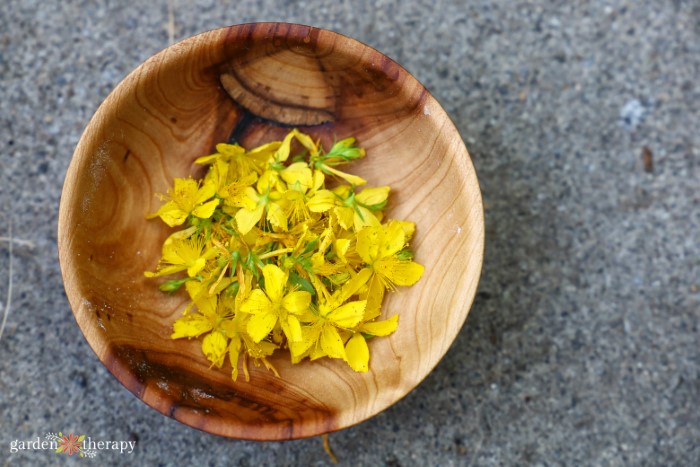
I’m a big fan of two-for-one plants. Anytime I can include a plant with two uses, I’m going to do it! So whenever there are edible flowers that not only look great but have a good taste or nutritional value, I’m going to do a happy dance.
What I love about edible wildflowers is that they require so little maintenance. Wildflowers often bloom in poor soil and come back year after year without any input from us humans.
All in all, they’re a very welcome addition to the garden. You set them and forget about them! Until you want to eat them, that is.
Ontario’s Wildflower Farm director Miriam Goldberger has joined us today to share a little bit of her favourite edible wildflowers.
In her book, Taming Wildflowers, Miriam tackles the myths surrounding wildflowers which unfairly portray them as unkempt, uncontrollable weeds. She aims to introduce gardeners to well-behaved wildflowers that conform to containers, gardens, and landscapes. What better way to start than with wildflowers you can eat?
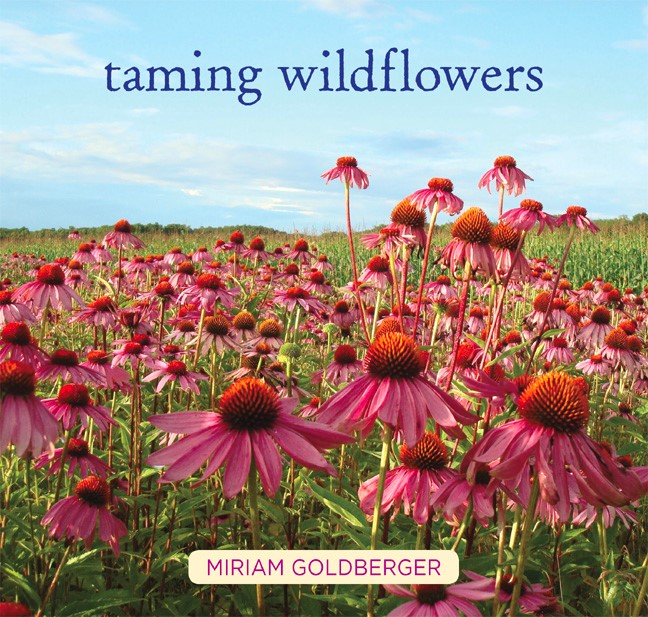
Reprinted with permission from Taming Wildflowers by Miriam Goldberger © 2014. Published by St. Lynn’s Press. Photography courtesy of St. Lynn’s Press.
This post will cover…
- Edible Wildflowers in the Garden
- Dandelion (Taraxacum officinale)
- Ohio Spiderwort (Tradescantia ohiensis)
- Wild Violets (Viola sororia)
- St. John’s Wort (Hypericum perforatum)
- Wild Bergamot (Monarda fistulosa)
- Chickweed (Stellaria media)
- California Poppies (Eschscholzia californica)
- Lavender Hyssop (Agastache foeniculum)
- Purple Dead Nettle (Lamium purpureum)
- Evening Primrose (Oenothera biennis)
- Roses and Rose Hips (Rosa spp.)
- Nodding Wild Onion (Allium cernuum)
- White Yarrow (Achillea millefolium)
- Chamomile (Matricaria recutita, Chamaemelum nobile)
- More Plants for Foraging
Edible Wildflowers in the Garden
You might already have some of these wildflowers you can eat growing in your garden! See if one of these beauties plays double duty as an edible wildflower.
Dandelion (Taraxacum officinale)
Dandelions are everywhere, and you might be surprised to learn how delicious the flowers can be when you fry them up. I like to dip them in tempura batter and then fry them in oil for a crunchy and savoury treat.
You can even eat the leaves and the root, as they’re actually super green. They have more vitamins than kale and spinach!
I love dandelions, making infused dandelion oil for my beauty recipes like this dandelion salve.
Just ensure that if you eat the dandelions, they come from your own backyard or somewhere else safe. Many people like to spray dandelions with herbicides which you definitely do not want to ingest.
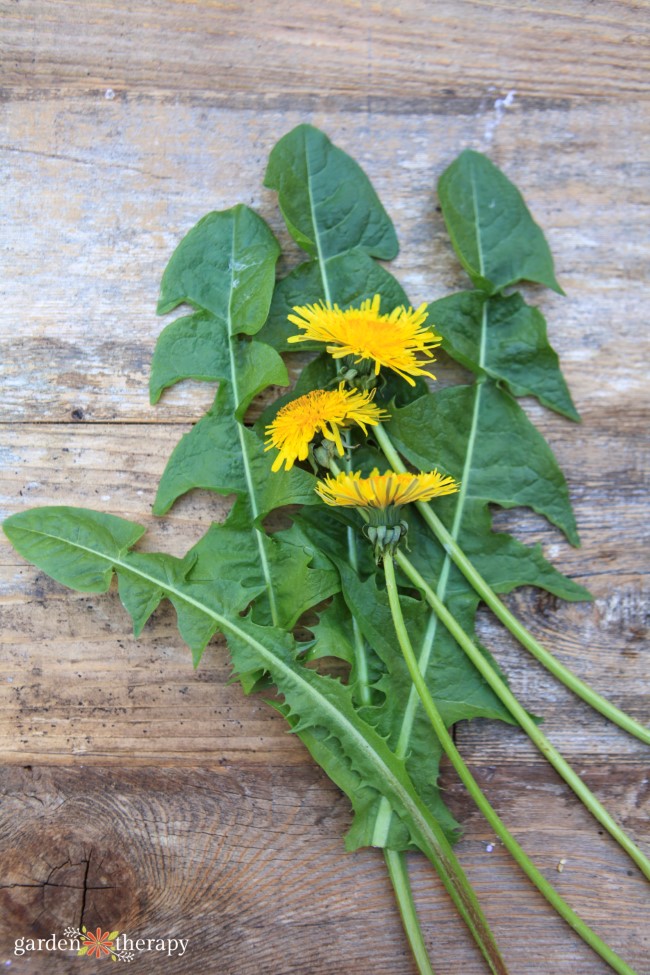
Ohio Spiderwort (Tradescantia ohiensis)
Ohio spiderwort has grass-like leaves topped with three-petaled flowers that come in white, pink, and blue. The flowers open in the morning and only last for the day, closing by the afternoon. But each plant will bloom more than once from spring to early summer.
“I prefer to use the Spiderwort flowers as colourful, cucumber-flavoured additions to a leafy green salad,” says Miriam. “In doing research for my book, I also found out that other parts of the Spiderwort plant are eaten, although less frequently. The leaves can be used in salads or made into a tea, and the seeds can be roasted and ground into a fine edible powder.”
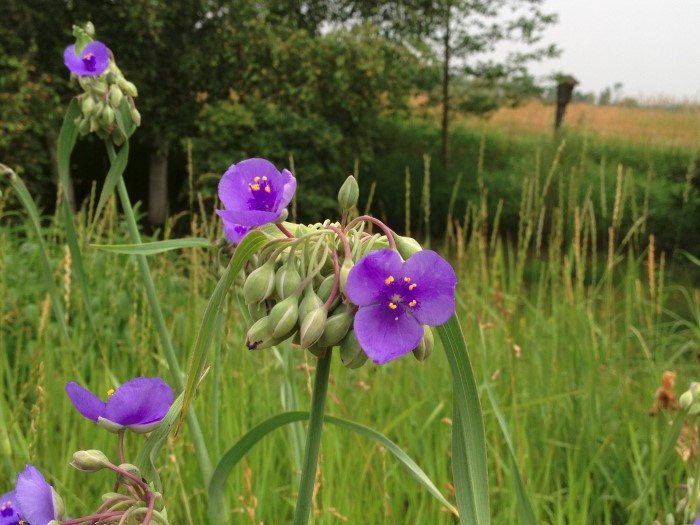
Wild Violets (Viola sororia)
Also called the common blue violet, these small flowers are found in many meadows and lawns. While many call them a weed, they’re quite harmless and add some cuteness to a lawn if you ask me.
Wild violets are edible wildflowers native to North America and can come in either blue, purple, white, or yellow. They have small, heart-shaped leaves, the flowers popping up in early spring,
Make this a simple syrup using wild violets for use in cocktails and sodas.
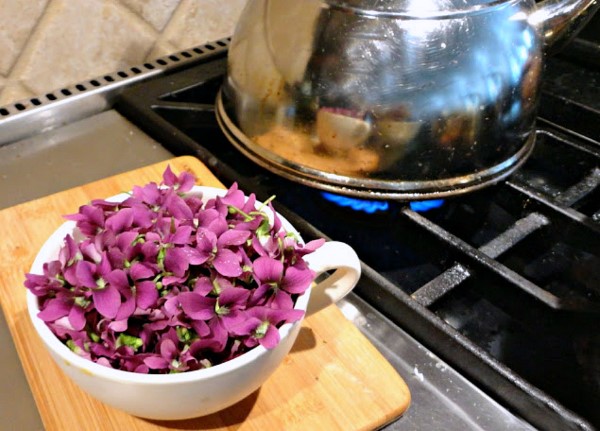
St. John’s Wort (Hypericum perforatum)
St. John’s wort is such a sunny and pretty flower, but it’s also a powerful plant packed with medicinal and herbal benefits. It can grow up to 3 feet and has a woody base. At the top of the branches, you’ll find the small, yellow clustered flowers.
St. John’s Wort is an edible wildflower, but it’s not really used for eating. It’s more so used for its medicinal properties, like reducing pain.
If you want to enjoy St. John’s Wort, try steeping the fresh flowers in tea. The fresh flowers have lots of hypericin, the main medicinal component. Crush the flowers when harvesting and look for the red hypericin. Then you know it’s ready for harvesting!
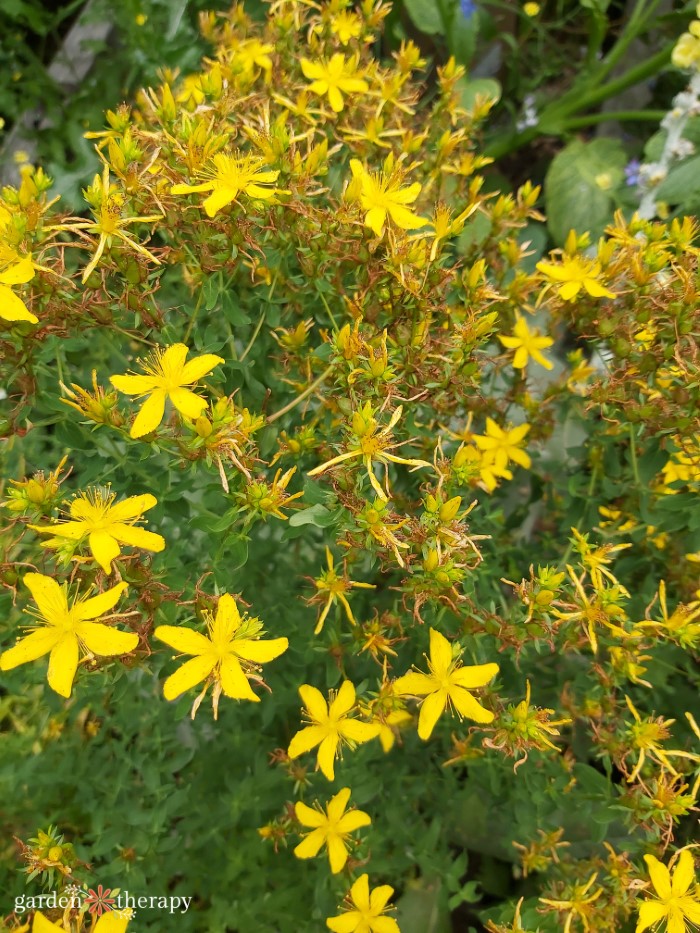
Wild Bergamot (Monarda fistulosa)
You may know wild bergamot by its other name, bee balm. Part of the mint family, it grows in clusters of lavender, white, or pink and has a minty scent. The flower blooms from early to mid-summer and you’re bound to see a butterfly or two visiting.
“I love to use Bergamot’s pretty purple flowers to make myself a nice cup of minty tea,” says Miriam. “They can be used dried or fresh for this and can also be added into salads and eaten raw. The leaves are edible, making great additions to salads.”
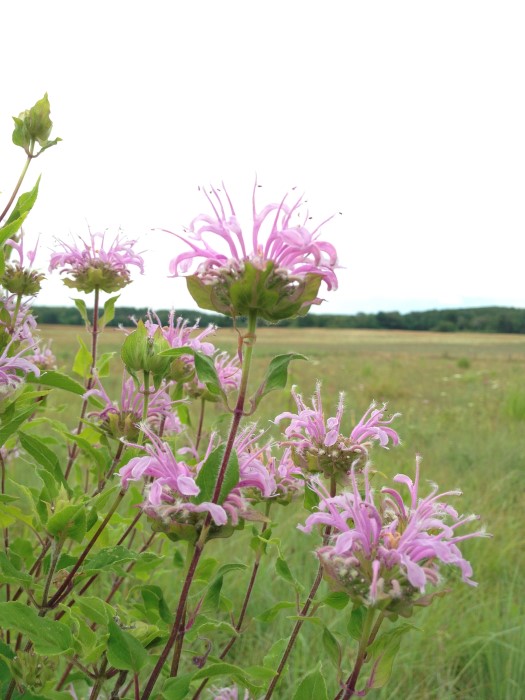
Chickweed (Stellaria media)
If you’re not looking for it, you might not spot chickweed. This small edible wildflower, most often referred to as a weed, blends into gardens, lawns, and forests.
Chickweed begins to spring in early spring and likes cool weather. It grows in large patches, with a small root system that makes it easy to tug out. The patches become large mats of light green leaves and white flowers with five petals. The stems also have fine white hairs.
Chickweed is pretty nutritious and can be eaten raw in salads. It’s also popular with chickens, hence its name.
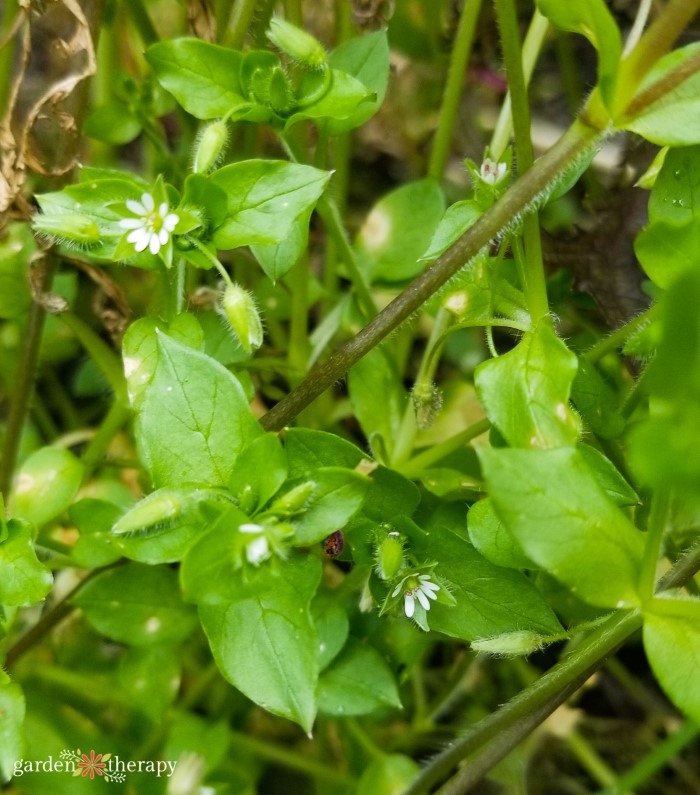
California Poppies (Eschscholzia californica)
California poppies don’t mind bad soil and rocky areas, meaning they can pop up in all kinds of places. And we welcome their bright colours! They’re often a creamsicle orange but can also come in yellow to dark orange shades.
You can use fresh poppies to adorn and garnish salads or use them dried to put in your baking. The taste is lightly sweet with a slightly bitter aftertaste.
If you want to use them fresh, you’ll need to pick them right before you use them. Poppies are famously wimpy flowers that are quick to wilt and fall apart.

Lavender Hyssop (Agastache foeniculum)
Lavender hyssop produces shows of spikey, tubular purple-blue flowers that bloom in mid to late summer. When bruised, the leaves give off the scent of anise. They’re commonly found in prairies and dry forested areas and fields.
“Lavender Hyssop’s alter ego is “Licorice Hyssop” and for good reason,” says Miriam. “I use the leaves and flowers together to make a minty licorice tea. Steep 2-3 tablespoons of bruised fresh leaves and several flowers in two cups of boiled water for 5 minutes. Can be enjoyed hot or iced.”

Purple Dead Nettle (Lamium purpureum)
Part of the mint family, this wildflower you can eat is another nutritious green superfood. You can eat the leaves, though they’re fuzzy, so they maybe best mixed with other greens. The flowers themselves are slightly sweet.
While native to Europe and Asia, purple dead nettle is also pretty common in North America. The bees do love it worldwide.
The leaves look similar to others in the mint family, with fuzz growing on them and a square stem. At the top of the plant, the leaves turn a purplish colour and then sprout pinky-purple flowers.
Some mistake henbit (Lamium amplexicaule) for purple dead nettle. I wouldn’t worry about this too much as henbit is another edible wildflower, so there’s no danger in mixing them up.
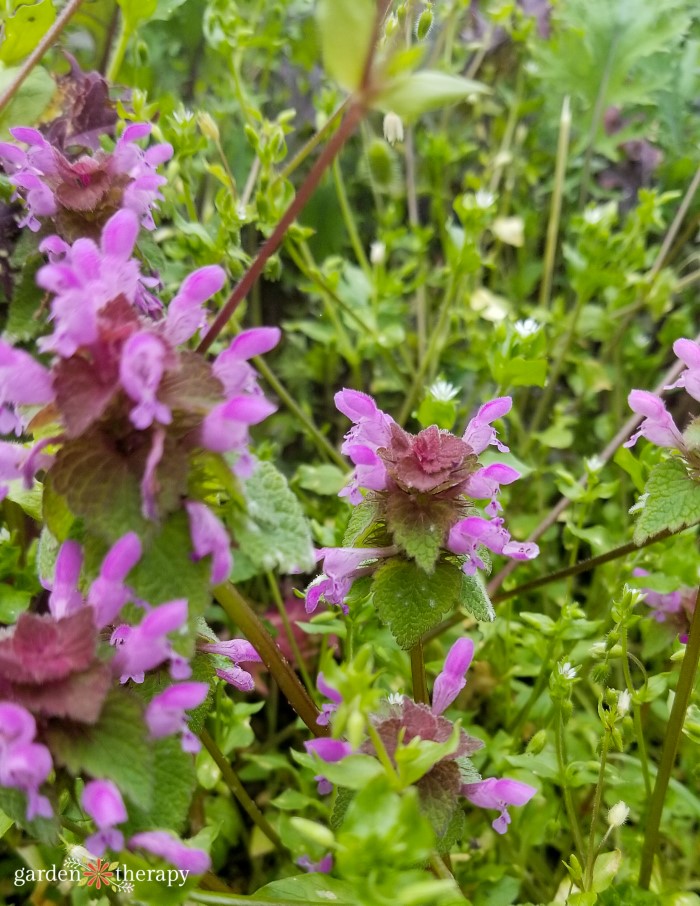
Evening Primrose (Oenothera biennis)
You might smell evening primrose before you see it. This fragrant flower has lemon-scented yellow flowers that are very prolific from early summer through early fall. Hence the name, the flowers open in the evening and stay out until late morning.
“Another plant that can be eaten in its entirety, says Miriam. “The seeds can be used like poppy seeds, to decorate breads and cookies. The bright yellow flowers are great in salads, and the leaves can be used cooked or raw. Be mindful, though; the taste is fairly strong.”
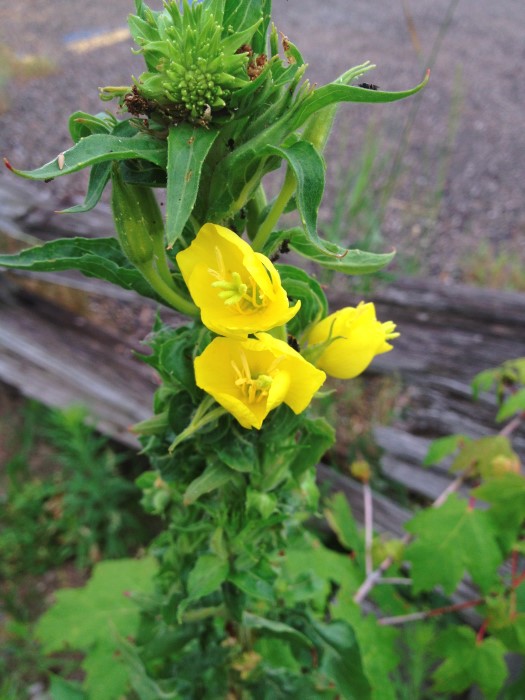
Roses and Rose Hips (Rosa spp.)
Roses are one of my all-time favourite skincare herbs. But of course, they’re also edible! You can grow wild roses in your garden as edible wildflowers, but any cultivated roses will have the same benefits and taste as wild roses.
My favourite way to enjoy the flavour of roses is by making rose water. You can add it to drinks and baked goods for a floral flavour. Or use it directly on your skin!
Roses bloom in late spring through to early summer. When the flowers are left, they turn into rose hips in early fall. The fruit of the rose bush, they’re quite nutritious as they’re packed with vitamin C and antioxidants.
Nodding Wild Onion (Allium cernuum)
There are many beautiful and edible members of the allium family, but the nodding onion is one edible wildflower you might find out in rocky soils and open woods. It’s most notably different than other onions by the flower scapes pointing downwards so the plant also points down and nods.
“As its name implies, the Nodding Wild Onion is a member of the onion family. The entire plant is edible and has a strong onion smell when bruised. I find that cooking the onion removes the strong flavours and leaves a milder taste behind,” says Miriam.
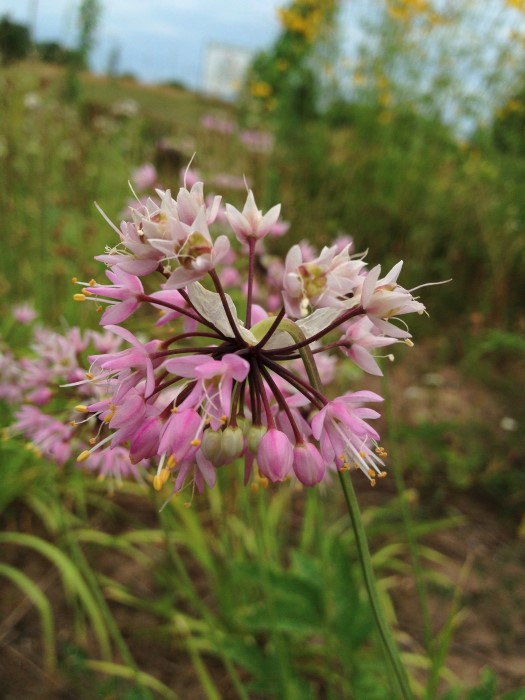
White Yarrow (Achillea millefolium)
Yarrow is not hard to find, sprouting up in gardens, meadows, and disturbed areas. It’s usually white or pink, but you can find cultivated yellow, orange, and red versions.
The entire plant is edible, from flower to root, and many have different medicinal purposes. It has feathery leaves and grows tight clusters or small, daisy-like flowers.
“Yarrow’s flavour is strong and bitter; it’s not very good raw but makes a great spice when the leaves are dried and crushed. I like to add it to meat dishes,” says Miriam.
When foraging for yarrow, make sure to identify it properly. It can also get mixed up with Queen Anne’s lace, which is edible, and poison hemlock, which is very toxic.
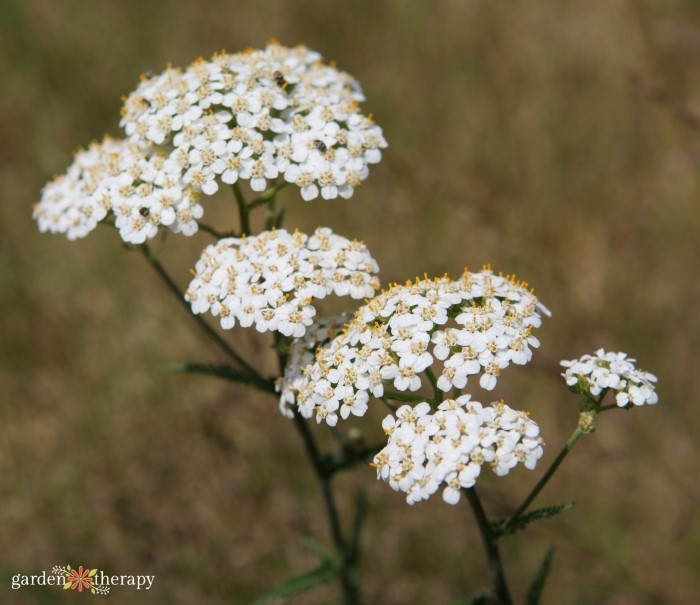
Chamomile (Matricaria recutita, Chamaemelum nobile)
Chamomile is everyone’s favourite sleepy tea. Ingesting chamomile can help soothe upset stomachs, calm the nervous system, and yes, help put you to sleep.
Chamomile has large yellow centers surrounded by white petals, forming a daisy-like appearance. The leaves are light green and feathery. If you get up close, it has a sweet apple smell.
You may also encounter pineapple weed (Matricaria discoidea), which is also referred to as wild chamomile. It is also edible and has similar medicinal uses. It looks very similar to chamomile, except it doesn’t have white petals. Pineapple weed tea tastes quite delicious!
Another mix-up may be feverfew (Tanacetum parthenium). It’s also a wonderful medicinal herb known best for helping with migraines.
So while you may be looking for chamomile, you may find some other edible wildflowers instead!
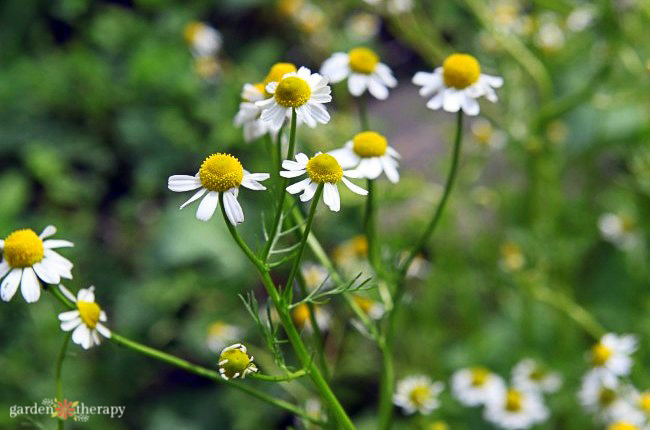

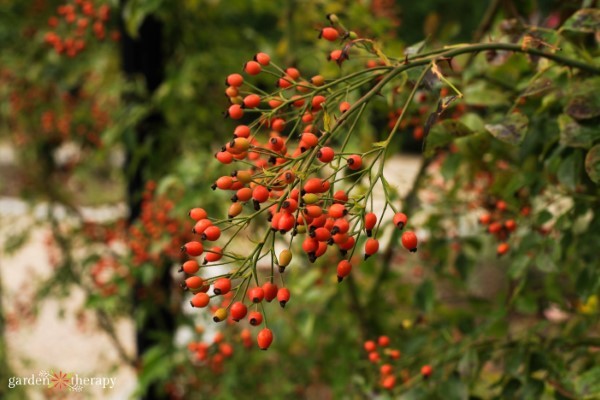
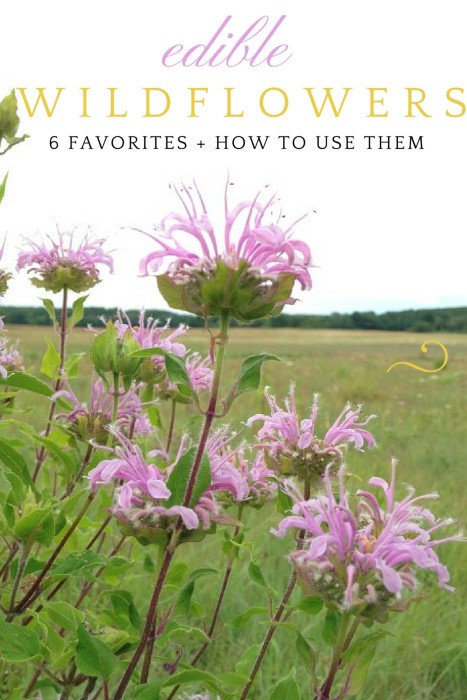



Beautiful pictures. Thank you for posting
This is good to know! I should check out her book!
Personally, I think knowing all the good, edible things that grow in the wild is needful anyways. There are so many medicinal plants and so many good things out there, that I’m constantly amazed at what everything can do. And yet, we frequently pass by these things without knowing what they’re used for.
I got good ideas from this amazing blog. I am always searching like this type blog post. I hope I will see again.
The flowers are so beautiful, I would like to have them in my garden to have a look every day. Thank you.
Creating these beautiful flowers takes a lot of time, so I do not want to eat them.